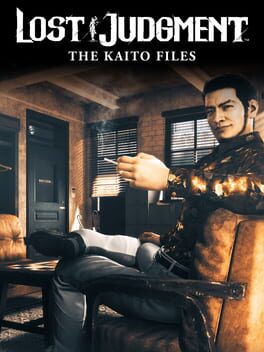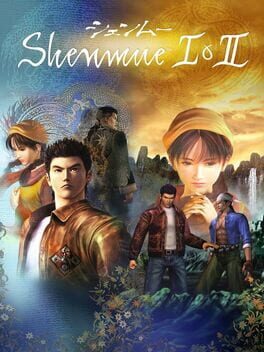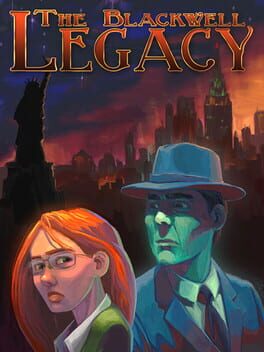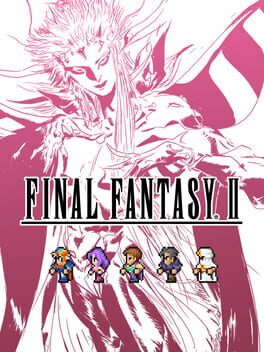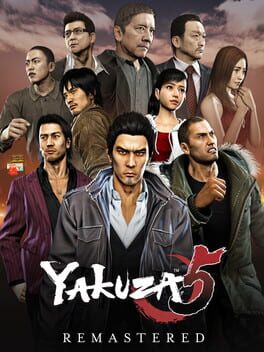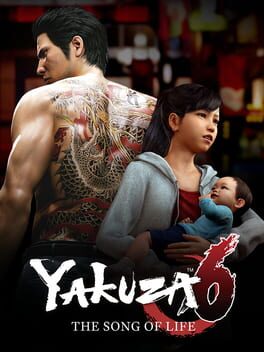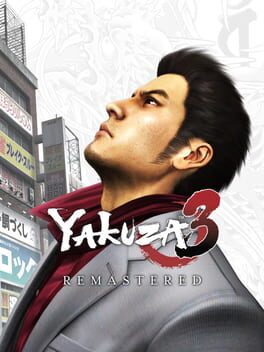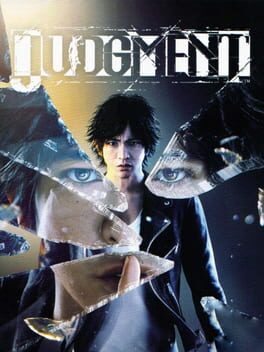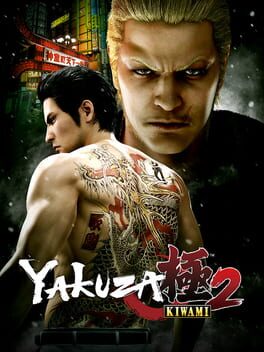killerrabbitdk
33 reviews liked by killerrabbitdk
It's actually kind of insane how good this is despite its position as a post-launch DLC. RGG took Kaito, a fan favorite character who deserved more time in the spotlight, and wrote an immensely compelling personal story for him. I wouldn't call any of the mainline Yakuza games bloated (maybe 5, but personally I don't feel like it's a bad thing), but trimming the usual fat and instead writing a no-nonsense 7 hour campaign was genius.
Purely by chance, I replayed the ending to the Majima Saga last week, and it's night and day when comparing the quality of these two releases. MS was lacking in unique content with only a couple fights, no real side objectives, and no fighting styles, making it feel pretty blatantly like reused content. Kaito Files, on the other hand, gives Kaito two unique styles with a large skill tree to upgrade through, some pretty funny side content in the form of his primal senses, and an absolute BOATLOAD of fights. In fact, the Kenmochi fight is maybe one of the best in the series.
The story itself is paced to perfection, jumping from beat to beat at a solid chop. For only 4 chapters and about 6-7.5 hours, it covered way more than I expected. The antagonist's motives aren't that shocking if you're familiar with the series, but the lengths he goes to end up being way darker than I expected, resulting in a pretty original tonal structure for the series. The finale is quite good. The epilogue after it, however, is hilarious. The mix of current and past Kaito is really interesting, Mikiko is a strong contender for best female in the series, and Jun's storyline is grounded and hits the mark 9 times out of 10. Special points for all the fanservice, like the constant Higashi gags and funny interactions with other series regulars. Yagami's texts explaining his absence are a treat.
On the gameplay side, Kaito's moveset is fantastically fun, adapting parts of Kiryu (some literally canonically taken from what Kaito has heard of Kiryu) but adding unique animations and new options to make it feel very fresh and fun. There are actually a few DMC-esque button + stick motion input moves, which are pretty rare for this series. I think 0 has a few? There are some pretty funny QoL things too, like Kaito getting an upgrade to wear his disguises freely around Kamurocho, something Yagami couldn't do in either game. The boss fights are fantastic, with some really good choreography and setpieces. The overall presentation here is slick as hell. Also, KF might actually make better use of the detective sequences than the main game does, there's some cool stuff in here.
I wasn't really sure what to expect with Kaito Files, especially for the $30 price point, but it delivered way more than I expected. This is essentially a mini Yakuza game with a surprisingly tight and impactful storyline, fantastic character moments, and the usual addictive gameplay. Highly recommended.
Purely by chance, I replayed the ending to the Majima Saga last week, and it's night and day when comparing the quality of these two releases. MS was lacking in unique content with only a couple fights, no real side objectives, and no fighting styles, making it feel pretty blatantly like reused content. Kaito Files, on the other hand, gives Kaito two unique styles with a large skill tree to upgrade through, some pretty funny side content in the form of his primal senses, and an absolute BOATLOAD of fights. In fact, the Kenmochi fight is maybe one of the best in the series.
The story itself is paced to perfection, jumping from beat to beat at a solid chop. For only 4 chapters and about 6-7.5 hours, it covered way more than I expected. The antagonist's motives aren't that shocking if you're familiar with the series, but the lengths he goes to end up being way darker than I expected, resulting in a pretty original tonal structure for the series. The finale is quite good. The epilogue after it, however, is hilarious. The mix of current and past Kaito is really interesting, Mikiko is a strong contender for best female in the series, and Jun's storyline is grounded and hits the mark 9 times out of 10. Special points for all the fanservice, like the constant Higashi gags and funny interactions with other series regulars. Yagami's texts explaining his absence are a treat.
On the gameplay side, Kaito's moveset is fantastically fun, adapting parts of Kiryu (some literally canonically taken from what Kaito has heard of Kiryu) but adding unique animations and new options to make it feel very fresh and fun. There are actually a few DMC-esque button + stick motion input moves, which are pretty rare for this series. I think 0 has a few? There are some pretty funny QoL things too, like Kaito getting an upgrade to wear his disguises freely around Kamurocho, something Yagami couldn't do in either game. The boss fights are fantastic, with some really good choreography and setpieces. The overall presentation here is slick as hell. Also, KF might actually make better use of the detective sequences than the main game does, there's some cool stuff in here.
I wasn't really sure what to expect with Kaito Files, especially for the $30 price point, but it delivered way more than I expected. This is essentially a mini Yakuza game with a surprisingly tight and impactful storyline, fantastic character moments, and the usual addictive gameplay. Highly recommended.
Shenmue I & II
2018
In January of this year (2023) I was going through an extremely bad period of my life. My depression was at an all time low, and I started to show a few symptoms of being schizotypal (which have since disappeared a little bit). Around the same time, the next game in my backlog was this game.
As I was playing it, something strange happened. I started to feel extremely happy. Shenmue taught me about the intricacies of life: how to keep a schedule, how to be more friendly towards people, how to explore and interact with the world around you, and so much more. It does seem silly to talk about how a game has changed the way you act in real life, but it happened for me.
For a game to do this to a human means it transcends the lowly status of being a "video game". Shenmue I & II is a magnificent sprawling work of perfection that rarely shows its age. Everyone should play it; not just gamers, but salarymen, wives, children... everyone.
As I was playing it, something strange happened. I started to feel extremely happy. Shenmue taught me about the intricacies of life: how to keep a schedule, how to be more friendly towards people, how to explore and interact with the world around you, and so much more. It does seem silly to talk about how a game has changed the way you act in real life, but it happened for me.
For a game to do this to a human means it transcends the lowly status of being a "video game". Shenmue I & II is a magnificent sprawling work of perfection that rarely shows its age. Everyone should play it; not just gamers, but salarymen, wives, children... everyone.
Alan Wake Remastered
2021
I first started Alan Wake years ago, but only got into the tutorial before my attention wandered. After playing Control on release and with the hype for Alan Wake 2 building, I figured it was time to sit down and play through the remaster. While this is still probably the right call for maximum enjoyment of the sequel, I found the original game to be dull, frustrating, overly long, needlessly repetitive, and honestly outright bad.
The story is Alan Wake’s only real appeal. What clearly begins by resting on the laurels of Twin Peaks does blossom (with the help of the excellent Control) into a wider narrative that is genuinely engaging. For the most part, anyway. I won’t go into too many specifics because I do think that’s what makes the game tick. It’s relatively well delivered, but paced terribly and is overly vague. There are a couple details that get expanded on in the DLC and the spinoff Alan Wake’s American Nightmare that do originate from this game, but… they’re not really actually explained. Even the wiki is a little unclear about how certain details line up. It stinks that you have to get info from so many other places to see the full broader narrative, but I guess that was the intent from the start, so it’s hardly worth criticizing. The full cast is shockingly small, with really only Alan and Barry and the Anderson brothers being consistent characters. Agent Nightingale is basically absent from the story and the other Bright Falls residents are genuinely window dressing. Still, despite these issues, there is an appeal here. YMMV if the game itself is worth trudging through for that.
The real death knell for Alan Wake is the gameplay. For a narrative focused game, almost nothing you do is related to the actual narrative. The cutscenes and manuscripts tell the story, and the bulk of the chapters (“Episodes”) of the game itself are mostly traipsing through forest segments fighting shadow people. The third person shooting mechanics here are laughably shallow. Alan’s flashlight burns the darkness off of infected people - “Taken” - (who I guess are beyond saving despite that, because he then kills the shit out of them) and your weapons kill them.
You have a pistol, a shotgun, a hunting rifle, and a variation of each (ex: pump shotgun). Flares act as “get off me” tools and flashbangs are grenades. That’s about it. Alan moves like a tank through a swimming pool of high-grade molasses, and his stamina is awful, giving you very little mobility in fights. A not-super-reliable dodge can save you sometimes, but once you’re surrounded you’re likely to take damage regardless, as the terrible camera and bad environmental design allows enemies to easily swarm you. There are really only about 5 enemies, and they’re all variations on either lumberjacks or fishermen. I figured from the first chapter that this was an aesthetic choice for that part of the story, and I would go on to fight, say, Taken engineers, or Taken chefs or something. No, it’s just lumberjacks all the way down. The game loves to just send Alan into the woods to fight things, and it is actually a majority of this game’s runtime. I cannot stress just how dull and repetitive these sections are - I groaned audibly when I figured a chapter was ending only to find out I had multiple more forest segments to go. The game also only knows to switch things up by taking away your weapons, not by throwing new enemies or challenges at you. Alan will regularly get into a car / helicopter / window accident that causes him to run into the woods, having forgotten or lost his guns and ammo, forcing you to scavenge new ones that are exactly the same. The game will throw a wave or two of enemies at you over and over until you reach a checkpoint, get given ammo for every gun you have, heal, and then do it again.
To be a little more analytical, Alan’s iconic flashlight doesn't work effectively as a mechanic since it is REQUIRED to make enemies vulnerable - there's nothing clever you can do to manage a crowd like in Resident Evil 4, you literally just have to focus one Taken at a time and kill them all. The addition of the flares and flashbangs helps, but these are just an escape from the central mechanics being extremely weak. The level design is atrocious, and it feels like the increase in enemy numbers is always hiding the fact that the mechanical depth is simply not enough to create any meaningful sense of progression throughout, resulting in a need to bury the player under the weight of sheer numbers and the time it takes to flashlight each enemy down before killing them.
In terms of pacing, there's rarely any payoff to a bunch of different objectives - when Alan runs from the cops (sigh... into the forest) and he sees the radio station, you'd think that once you get there you'll get character building, context, even just a break from woods-walking. Nope, the second you see the DJ inside, a cutscene plays and the cops shoot at Alan through the window so he jumps out and runs into the forest. Not a single second of this exchange is worth anything, it is blatant and embarrassing filler. The player is teased with an objective, a possible meeting with another character, a break from the mediocre gameplay - only to have it last less than 20 seconds before returning you to a carbon copy of what you did for the last 15 minutes. The other objectives outside the woods feel like busywork: get this gate open, go get a generator running, etc. Episode 5’s walk through the abandoned Bright Falls is a real highlight of the game as it is not just a break from forest segments, but also feels connected to the narrative and worth engaging with.
some bullet points:
- sheriff breaker is an agent of the bureau of control, which is kind of awesome
- there's this one clip of the dark presence taking Alan's wife that plays probably 10 times in the story when he like has a flash of pain in his head and it's only like 0.8 seconds long and it repeated so many times i thought my game was bugged
- Nightingale calling Wake different authors' names is pretty funny
- the possessed barrels and girders flying at you suck so much
- i hope you like Adidas bc this game could be an ad for it with how much that one enemy in the tracksuit shows up
- Barry gets a head torch and Alan wants it. yeah me too man, me too
- that final "boss" is such a whimper to end a game on
- the whole final act is weirdly quick and anticlimactic for a game that's already double the length it should be
- the episodes of Night Springs that play on tvs are the most well written part of the game, they really capture the tone that makes Control feel so special
I feel like I haven’t even really touched on how many things about this game bothered me, but I’m going to end there. A truly frustrating and dull experience that offers gameplay so wretched that I did consider stopping and watching a Lets Play for the last half. While looking some stuff up about it, I saw someone say that they believed this was the best linear third person shooter ever made. I truly hope for their sake that they played RE4 or Dead Space after they made that comment, because it is a grim statement otherwise.
The story is Alan Wake’s only real appeal. What clearly begins by resting on the laurels of Twin Peaks does blossom (with the help of the excellent Control) into a wider narrative that is genuinely engaging. For the most part, anyway. I won’t go into too many specifics because I do think that’s what makes the game tick. It’s relatively well delivered, but paced terribly and is overly vague. There are a couple details that get expanded on in the DLC and the spinoff Alan Wake’s American Nightmare that do originate from this game, but… they’re not really actually explained. Even the wiki is a little unclear about how certain details line up. It stinks that you have to get info from so many other places to see the full broader narrative, but I guess that was the intent from the start, so it’s hardly worth criticizing. The full cast is shockingly small, with really only Alan and Barry and the Anderson brothers being consistent characters. Agent Nightingale is basically absent from the story and the other Bright Falls residents are genuinely window dressing. Still, despite these issues, there is an appeal here. YMMV if the game itself is worth trudging through for that.
The real death knell for Alan Wake is the gameplay. For a narrative focused game, almost nothing you do is related to the actual narrative. The cutscenes and manuscripts tell the story, and the bulk of the chapters (“Episodes”) of the game itself are mostly traipsing through forest segments fighting shadow people. The third person shooting mechanics here are laughably shallow. Alan’s flashlight burns the darkness off of infected people - “Taken” - (who I guess are beyond saving despite that, because he then kills the shit out of them) and your weapons kill them.
You have a pistol, a shotgun, a hunting rifle, and a variation of each (ex: pump shotgun). Flares act as “get off me” tools and flashbangs are grenades. That’s about it. Alan moves like a tank through a swimming pool of high-grade molasses, and his stamina is awful, giving you very little mobility in fights. A not-super-reliable dodge can save you sometimes, but once you’re surrounded you’re likely to take damage regardless, as the terrible camera and bad environmental design allows enemies to easily swarm you. There are really only about 5 enemies, and they’re all variations on either lumberjacks or fishermen. I figured from the first chapter that this was an aesthetic choice for that part of the story, and I would go on to fight, say, Taken engineers, or Taken chefs or something. No, it’s just lumberjacks all the way down. The game loves to just send Alan into the woods to fight things, and it is actually a majority of this game’s runtime. I cannot stress just how dull and repetitive these sections are - I groaned audibly when I figured a chapter was ending only to find out I had multiple more forest segments to go. The game also only knows to switch things up by taking away your weapons, not by throwing new enemies or challenges at you. Alan will regularly get into a car / helicopter / window accident that causes him to run into the woods, having forgotten or lost his guns and ammo, forcing you to scavenge new ones that are exactly the same. The game will throw a wave or two of enemies at you over and over until you reach a checkpoint, get given ammo for every gun you have, heal, and then do it again.
To be a little more analytical, Alan’s iconic flashlight doesn't work effectively as a mechanic since it is REQUIRED to make enemies vulnerable - there's nothing clever you can do to manage a crowd like in Resident Evil 4, you literally just have to focus one Taken at a time and kill them all. The addition of the flares and flashbangs helps, but these are just an escape from the central mechanics being extremely weak. The level design is atrocious, and it feels like the increase in enemy numbers is always hiding the fact that the mechanical depth is simply not enough to create any meaningful sense of progression throughout, resulting in a need to bury the player under the weight of sheer numbers and the time it takes to flashlight each enemy down before killing them.
In terms of pacing, there's rarely any payoff to a bunch of different objectives - when Alan runs from the cops (sigh... into the forest) and he sees the radio station, you'd think that once you get there you'll get character building, context, even just a break from woods-walking. Nope, the second you see the DJ inside, a cutscene plays and the cops shoot at Alan through the window so he jumps out and runs into the forest. Not a single second of this exchange is worth anything, it is blatant and embarrassing filler. The player is teased with an objective, a possible meeting with another character, a break from the mediocre gameplay - only to have it last less than 20 seconds before returning you to a carbon copy of what you did for the last 15 minutes. The other objectives outside the woods feel like busywork: get this gate open, go get a generator running, etc. Episode 5’s walk through the abandoned Bright Falls is a real highlight of the game as it is not just a break from forest segments, but also feels connected to the narrative and worth engaging with.
some bullet points:
- sheriff breaker is an agent of the bureau of control, which is kind of awesome
- there's this one clip of the dark presence taking Alan's wife that plays probably 10 times in the story when he like has a flash of pain in his head and it's only like 0.8 seconds long and it repeated so many times i thought my game was bugged
- Nightingale calling Wake different authors' names is pretty funny
- the possessed barrels and girders flying at you suck so much
- i hope you like Adidas bc this game could be an ad for it with how much that one enemy in the tracksuit shows up
- Barry gets a head torch and Alan wants it. yeah me too man, me too
- that final "boss" is such a whimper to end a game on
- the whole final act is weirdly quick and anticlimactic for a game that's already double the length it should be
- the episodes of Night Springs that play on tvs are the most well written part of the game, they really capture the tone that makes Control feel so special
I feel like I haven’t even really touched on how many things about this game bothered me, but I’m going to end there. A truly frustrating and dull experience that offers gameplay so wretched that I did consider stopping and watching a Lets Play for the last half. While looking some stuff up about it, I saw someone say that they believed this was the best linear third person shooter ever made. I truly hope for their sake that they played RE4 or Dead Space after they made that comment, because it is a grim statement otherwise.
The Blackwell Legacy
2006
This review contains spoilers
Completed with 100% of achievements unlocked. Each game in the Blackwell series of point-and-click adventures is fairly short - completion is typically possible in 2-3 hours - but this means that they lend themselves to being seen as individual chapters of a wider story. The games follow Rosangela Blackwell, a spirit medium (or in Blackwell Unbound, her aunt) and her spirit guide, Joey, as they investigate various supernatural mysteries. Each scenario presents an intriguing story that maintains interest throughout, and beyond that, there's an ongoing plot between the games that's especially fascinating to see play out. In contrast to many point-and-click adventures, the primary puzzle-solving tool comes from dialog rather than item manipulation, a mechanic that works very well and suits the detective/investigator role that Rosangela typically takes.
Beyond actually playing the games, it's interesting to see how the game mechanics develop from game to game, as well as gradual improvements in graphical style. These is highlighted further by the inclusion of a commentary mode, a feature now common to games from Wadjet Eye, which brings with it some interesting (and occasionally, amusing) insights to the design and development process - I'd definitely recommend a playthrough in this mode to anyone with an interest in game design.
Beyond actually playing the games, it's interesting to see how the game mechanics develop from game to game, as well as gradual improvements in graphical style. These is highlighted further by the inclusion of a commentary mode, a feature now common to games from Wadjet Eye, which brings with it some interesting (and occasionally, amusing) insights to the design and development process - I'd definitely recommend a playthrough in this mode to anyone with an interest in game design.
I was a little worried that this game was dropping so soon after the first Voice of Cards game, but luckily my worries were misplaced! Pretty much everything positive I said about The Isle Dragon Roars also applies to The Forsaken Maiden - the presentation is great, the simple combat system is fun and addictive, and the writing is of the high quality you expect from a Yoko Taro project.
The thing that elevates The Forsaken Maiden above its predecessor is Laty. The entire story here is a character study of Laty, and it's phenomenal. Laty is mute so seeing her relationship grow with every character she meets gives you a really interesting look into her personality and character development without ever hearing her speak. Honestly one of the best character arcs I can think of in a JRPG, and its worth playing the game for even if it doesn't seem appealing to you otherwise.
The thing that elevates The Forsaken Maiden above its predecessor is Laty. The entire story here is a character study of Laty, and it's phenomenal. Laty is mute so seeing her relationship grow with every character she meets gives you a really interesting look into her personality and character development without ever hearing her speak. Honestly one of the best character arcs I can think of in a JRPG, and its worth playing the game for even if it doesn't seem appealing to you otherwise.
Xenoblade Chronicles
2010
I've come to view this game less highly over the years, but nothing can change the fact that it's a seminal RPG for many newer fans. The story is complex and well-realized. The world is a joy to explore and take in, with some genuinely impressive stuff for the hardware. Music is top-tier and really is half of why I like it so much. Combat has quite a few things to learn but there's some really cool ways to customize it, and it's fun to learn.
Characters can be rather lacking and the quests are often repititive and one-note, but I don't believe it's enough to drag down what is otherwise a great standalone JRPG.
Characters can be rather lacking and the quests are often repititive and one-note, but I don't believe it's enough to drag down what is otherwise a great standalone JRPG.
Final Fantasy II
2021
A (mostly) solid remaster of a JRPG that would've been extremely ambitious in its time, but aged like milk. I think the leveling system is really cool! The most fun I had in FF2 was grinding in the early game to do stuff that I shouldn't have been able to. It's fun to break a game over your knee like that. Unfortunately I think the leveling is by far the most interesting aspect of FF2, and once the novelty wears off you're left with a JRPG with some of the worst dungeon design I've ever seen and a sky high encounter rate. It's just not fun, and that's coming from an unironic Strange Journey stan.
I will say I'm much more willing to give SaGa a chance after this, cuz it can't be any worse.
I will say I'm much more willing to give SaGa a chance after this, cuz it can't be any worse.
Solid. Has some improvements over Odyssey, has some negatives that game doesn't. Probably not going to finish this but I've had fun with what I played. Combat is relatively good, feels meaty and you have lots of options. I was glad they included a setting for lethal assassinations. Eivor is a pretty fun personify protagonist, especially female. Her meeting Kassandra is probably quite fun, haven't played that DLC though. As usual, the "real world" story is boring as sin. Why they can't come up with new contexts other than "a person in 20XX is using an animus" is beyond me. Parkour is good, if pretty underused due to the rarity of towns. While I didn't get more than 30 hours in, the story is actually pretty good. The writing on the individual areas and the characters in each is above what I expected and the central plot seems appealing. The game's focus on the supernatural aspects of Norse culture is pretty cool and Eivor's visions are fun. The missions that actually play with reality are some of the best in the game, like the white horse hallucination. Raiding towns is fun.
There's not really anything that's reinventing the wheel that Origins and Odyssey built but Eivor is an enjoyable central figure in a story that's more engaging than I expected with the same quality of pseudo-RPG combat in this trilogy of games. Recommended for a straightforward good time.
There's not really anything that's reinventing the wheel that Origins and Odyssey built but Eivor is an enjoyable central figure in a story that's more engaging than I expected with the same quality of pseudo-RPG combat in this trilogy of games. Recommended for a straightforward good time.
Yakuza 5 Remastered
2019
This review contains spoilers
2-3 years after only playing Yakuza 0 to Kiwami 2, I've finally caught up with most of the Yakuza games. As for why I only played those 3 at first, I'm not quite sure myself truthfully. But this game...I don't even know where to start with this masterpiece. An emotionally devastating yet breathtaking end to Kiryu's story, now my favorite video game character. This is the best RGG has been with it's writing, completely unrivaled from characters to storytelling. It's not as ambitious in scope as Yakuza 5 was but it still does a good job in finalizing Kiryu's character and Haruka's relationship. The callbacks throughout this game were spectacular, each and every one of them making everything hit so much more harder. Even the substories are easily at it's best in this game, with surprisingly amazing writing throughout all of them.
Moving on to the gameplay itself, I really enjoyed the return of the Dragon Engine, albeit in an older state since this game released before Kiwami 2. I seriously don't think the Dragon Engine is that bad; and while yeah I do agree that 0's/5's/etc is better, It's still pretty fun for a prototype.
Finalizing my thoughts on this, I'm just glad I could experience the rest of Kiryu's journey throughout Kamurocho and the rollercoaster of emotion it offers. He is easily my favorite video game character ever as I've said before, and this game was pretty much confirmation of why. The RGG games as a whole has taught me a lot and I'm so glad I could experience these games. From beginning to end, it’s truly been an unforgettable journey.
Moving on to the gameplay itself, I really enjoyed the return of the Dragon Engine, albeit in an older state since this game released before Kiwami 2. I seriously don't think the Dragon Engine is that bad; and while yeah I do agree that 0's/5's/etc is better, It's still pretty fun for a prototype.
Finalizing my thoughts on this, I'm just glad I could experience the rest of Kiryu's journey throughout Kamurocho and the rollercoaster of emotion it offers. He is easily my favorite video game character ever as I've said before, and this game was pretty much confirmation of why. The RGG games as a whole has taught me a lot and I'm so glad I could experience these games. From beginning to end, it’s truly been an unforgettable journey.
